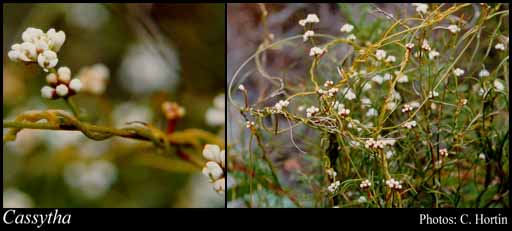- Reference
- Sp.Pl. 2:35 (1753)
- Name Status
- Current

Scientific Description
Common name. Dodder Laurel. Family Lauraceae.
Habit and leaf form. Herbaceous climbers; evergreen; bearing essential oils, or without essential oils. Leaves much reduced. Partially parasitic. On aerial parts of the host. Perennial. Young stems cylindrical. Climbing; stem twiners. Leptocaul. Mesophytic. Leaves alternate; spiral; membranous; petiolate; non-sheathing; gland-dotted; aromatic; simple. Leaf blades entire; ovate, or triangular. Leaves without stipules; without a persistent basal meristem. Leaf anatomy. Hairs present, or absent. Stem anatomy. Secondary thickening developing from a conventional cambial ring.
Reproductive type, pollination. Fertile flowers hermaphrodite. Unisexual flowers absent. Plants hermaphrodite.
Inflorescence and flower features. Flowers aggregated in ‘inflorescences’; erect in racemes, or in spikes, or in heads, or in umbels, or in panicles. The terminal inflorescence unit racemose, or cymose. Inflorescences axillary; with involucral bracts, or without involucral bracts. Flowers pedicellate, or sessile; bracteate; bracteolate; small; regular; 3 merous; cyclic. Free hypanthium present; turbinate. Hypogynous disk present, or absent. Perianth with distinct calyx and corolla; 6; 2 -whorled; isomerous; joined (there being a well developed hypanthium). Calyx present; 3; polysepalous; yellow, or brown; persistent. Sepals ovate, or triangular, or orbicular. Corolla present; 3; polypetalous; green, or white, or yellow. Petals elliptic, or ovate. Androecial members definite in number (in 4 whorls of 3). Androecium 12. Androecial members free of the perianth (on the hypanthium); free of one another; 4 -whorled (three per whorl). Androecium including staminodes. Staminodes 3, or 6, or 9. Stamens 3, or 6, or 9; attached on the rim of the hypanthium; distinctly dissimilar in shape; diplostemonous to polystemonous, or reduced in number relative to the adjacent perianth to isomerous with the perianth; petaloid (in outer whorl only), or filantherous. Filaments appendiculate, or not appendiculate. Anthers basifixed; non-versatile; dehiscing by longitudinal valves; introrse, or introrse and extrorse; bilocular, or four locular; bisporangiate, or tetrasporangiate, or bisporangiate and tetrasporangiate. Gynoecium 1 carpelled (ostensibly), or 3 carpelled (theoretically). The pistil 1 celled. Gynoecium ostensibly monomerous; of one carpel (or at least, ostensibly so); superior. Carpel stylate; apically stigmatic; 1 ovuled. Placentation apical. Ovules pendulous; non-arillate; anatropous.
Fruit and seed features. Fruit fleshy. The fruiting carpel indehiscent; drupaceous, or baccate, or nucular. Fruit enclosed in the fleshy receptacle, or enclosed in the fleshy hypanthium, or without fleshy investment; 1 seeded. Seeds non-endospermic. Embryo well differentiated (sic); straight.
Etymology. From the Greek for "dodder"; the plant resembles the dodder.
Taxonomic Literature
- Wheeler, Judy; Marchant, Neville; Lewington, Margaret; Graham, Lorraine 2002. Flora of the south west, Bunbury, Augusta, Denmark. Volume 2, dicotyledons. Australian Biological Resources Study.. Canberra..
- Grieve, B. J.; Blackall, W. E. 1998. How to know Western Australian wildflowers : a key to the flora of the extratropical regions of Western Australia. Part II, Dicotyledons (Amaranthaceae to Lythraceae). University of W.A. Press.. Nedlands, W.A..
- Wheeler, J. R.; Rye, B. L.; Koch, B. L.; Wilson, A. J. G.; Western Australian Herbarium 1992. Flora of the Kimberley region. Western Australian Herbarium.. Como, W.A..
- Marchant, N. G.; Wheeler, J. R.; Rye, B. L.; Bennett, E. M.; Lander, N. S.; Macfarlane, T. D.; Western Australian Herbarium 1987. Flora of the Perth region. Part one. Western Australian Herbarium.. [Perth]..
- Weber, J. Z. 1981. A taxonomic revision of Cassytha (Lauraceae) in Australia.